Health Care: Cultural and Social Diversity Case Study Analysis
VerifiedAdded on 2022/11/07
|12
|2958
|418
Case Study
AI Summary
This case study analyzes cultural and social diversity in healthcare, focusing on two distinct ethnic groups: Irish Australians and Aboriginal Australians. The study examines the impact of social determinants of health, including access to education, income, employment, and social security, on health outcomes. It explores health risk factors such as poor nutrition, tobacco smoking, and excessive alcohol consumption, along with the healthcare system's role in addressing health disparities. The study highlights the challenges faced by these groups and provides recommendations for improving healthcare access, promoting healthy lifestyles, and addressing the social determinants that contribute to health inequalities. Both cases underscore the importance of culturally sensitive healthcare practices and policies to achieve health equity. The analysis considers the role of healthcare access, health education, and the need for tailored interventions to address specific health challenges within each community.
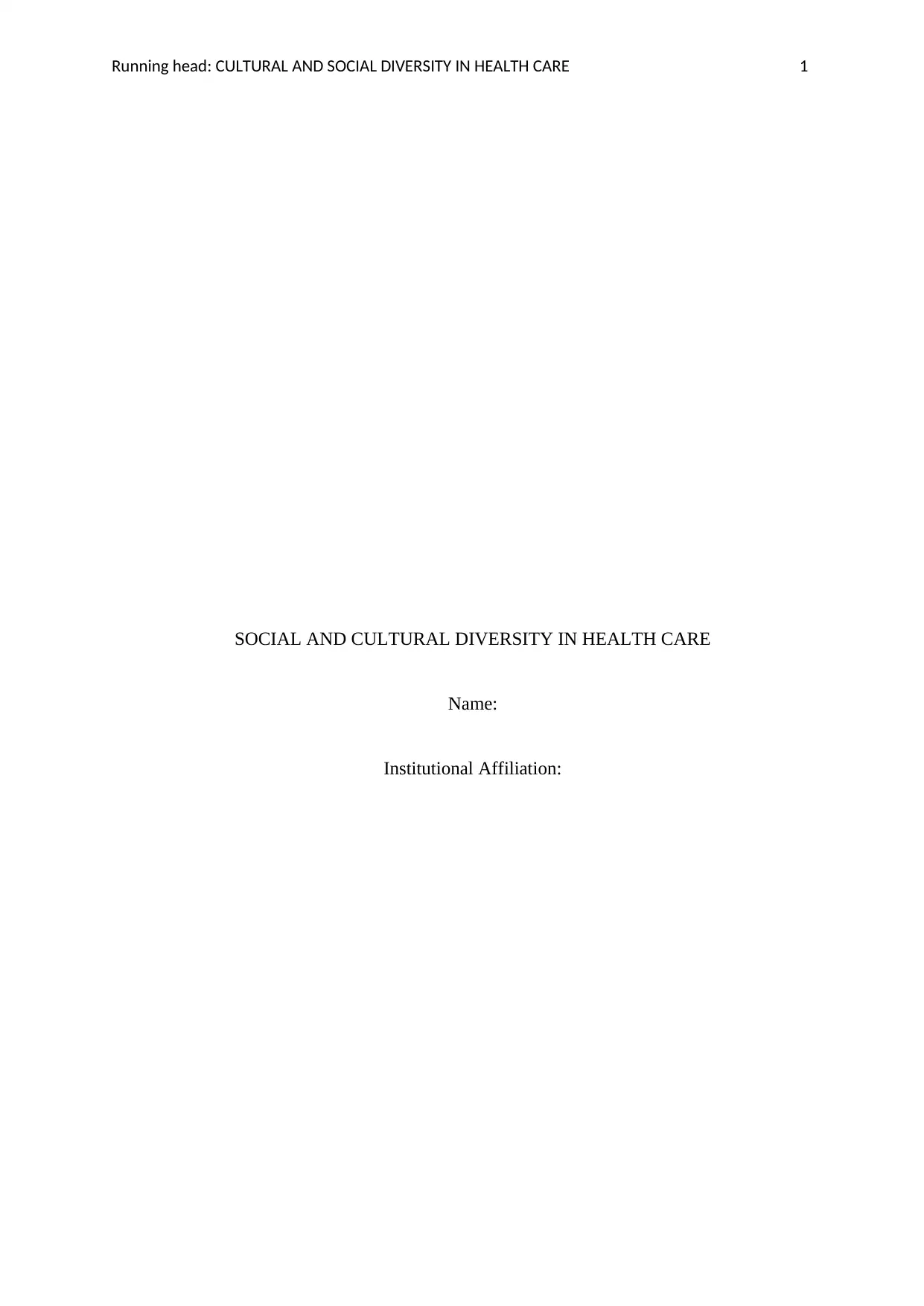
Running head: CULTURAL AND SOCIAL DIVERSITY IN HEALTH CARE 1
SOCIAL AND CULTURAL DIVERSITY IN HEALTH CARE
Name:
Institutional Affiliation:
SOCIAL AND CULTURAL DIVERSITY IN HEALTH CARE
Name:
Institutional Affiliation:
Paraphrase This Document
Need a fresh take? Get an instant paraphrase of this document with our AI Paraphraser
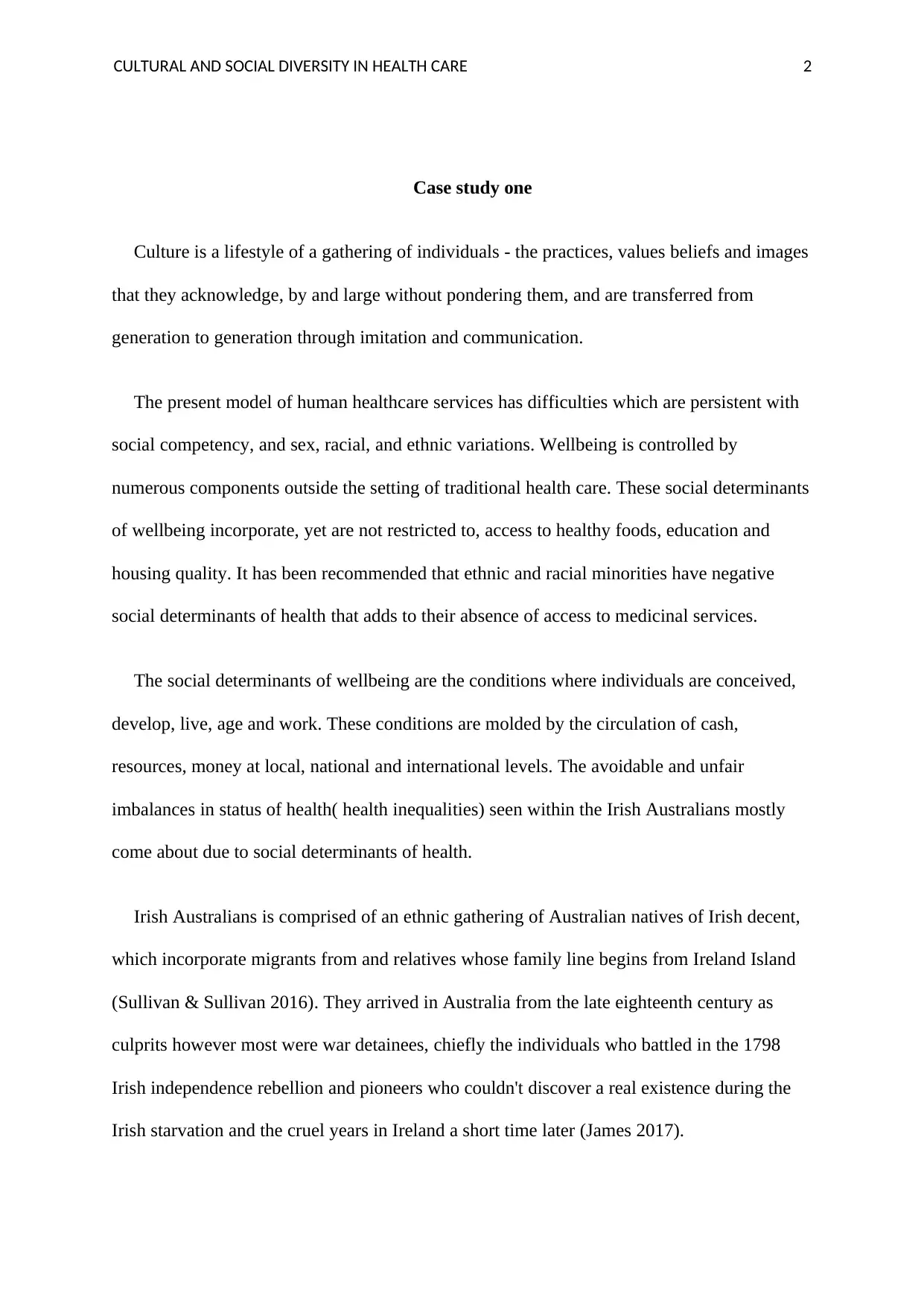
CULTURAL AND SOCIAL DIVERSITY IN HEALTH CARE 2
Case study one
Culture is a lifestyle of a gathering of individuals - the practices, values beliefs and images
that they acknowledge, by and large without pondering them, and are transferred from
generation to generation through imitation and communication.
The present model of human healthcare services has difficulties which are persistent with
social competency, and sex, racial, and ethnic variations. Wellbeing is controlled by
numerous components outside the setting of traditional health care. These social determinants
of wellbeing incorporate, yet are not restricted to, access to healthy foods, education and
housing quality. It has been recommended that ethnic and racial minorities have negative
social determinants of health that adds to their absence of access to medicinal services.
The social determinants of wellbeing are the conditions where individuals are conceived,
develop, live, age and work. These conditions are molded by the circulation of cash,
resources, money at local, national and international levels. The avoidable and unfair
imbalances in status of health( health inequalities) seen within the Irish Australians mostly
come about due to social determinants of health.
Irish Australians is comprised of an ethnic gathering of Australian natives of Irish decent,
which incorporate migrants from and relatives whose family line begins from Ireland Island
(Sullivan & Sullivan 2016). They arrived in Australia from the late eighteenth century as
culprits however most were war detainees, chiefly the individuals who battled in the 1798
Irish independence rebellion and pioneers who couldn't discover a real existence during the
Irish starvation and the cruel years in Ireland a short time later (James 2017).
Case study one
Culture is a lifestyle of a gathering of individuals - the practices, values beliefs and images
that they acknowledge, by and large without pondering them, and are transferred from
generation to generation through imitation and communication.
The present model of human healthcare services has difficulties which are persistent with
social competency, and sex, racial, and ethnic variations. Wellbeing is controlled by
numerous components outside the setting of traditional health care. These social determinants
of wellbeing incorporate, yet are not restricted to, access to healthy foods, education and
housing quality. It has been recommended that ethnic and racial minorities have negative
social determinants of health that adds to their absence of access to medicinal services.
The social determinants of wellbeing are the conditions where individuals are conceived,
develop, live, age and work. These conditions are molded by the circulation of cash,
resources, money at local, national and international levels. The avoidable and unfair
imbalances in status of health( health inequalities) seen within the Irish Australians mostly
come about due to social determinants of health.
Irish Australians is comprised of an ethnic gathering of Australian natives of Irish decent,
which incorporate migrants from and relatives whose family line begins from Ireland Island
(Sullivan & Sullivan 2016). They arrived in Australia from the late eighteenth century as
culprits however most were war detainees, chiefly the individuals who battled in the 1798
Irish independence rebellion and pioneers who couldn't discover a real existence during the
Irish starvation and the cruel years in Ireland a short time later (James 2017).
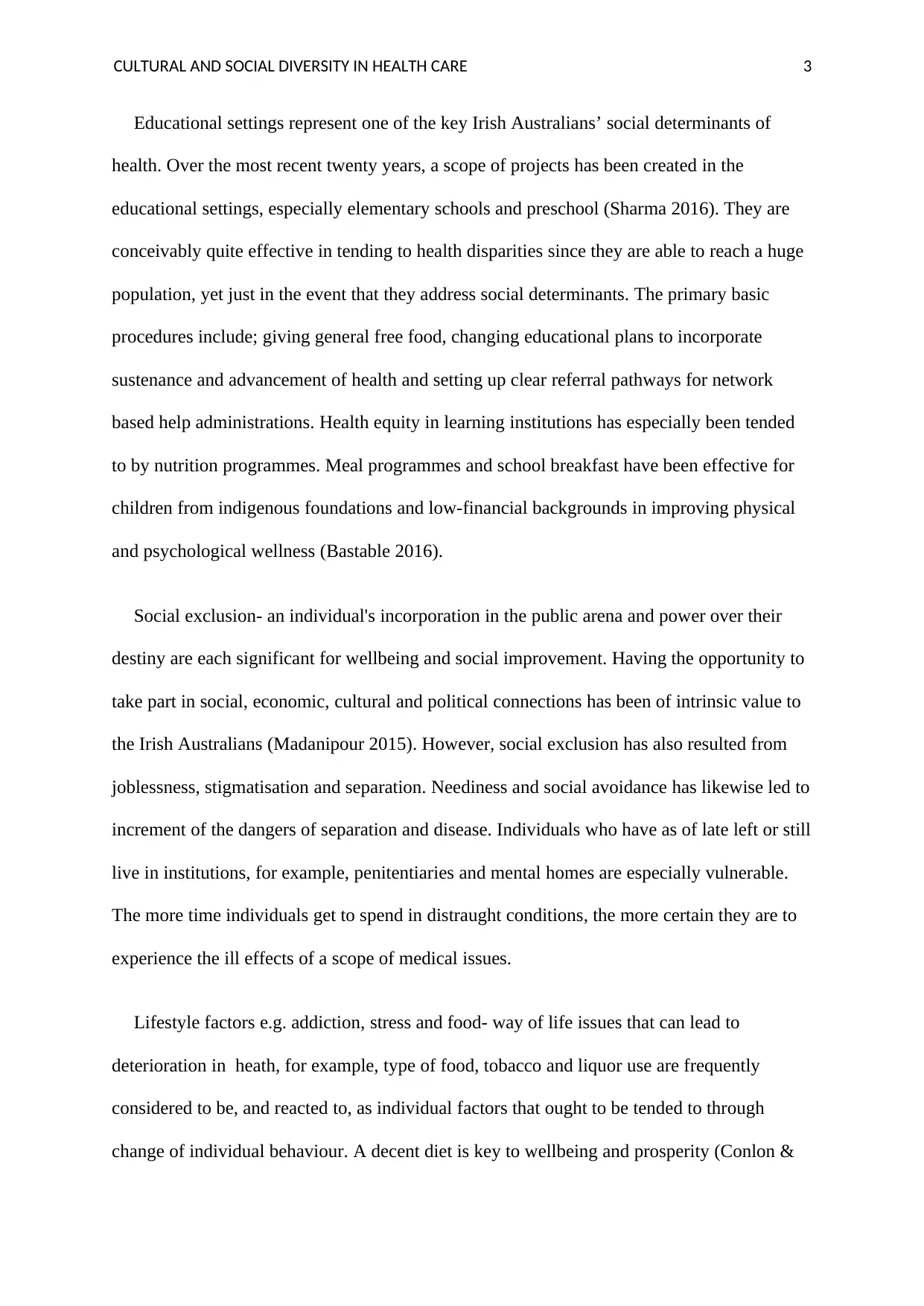
CULTURAL AND SOCIAL DIVERSITY IN HEALTH CARE 3
Educational settings represent one of the key Irish Australians’ social determinants of
health. Over the most recent twenty years, a scope of projects has been created in the
educational settings, especially elementary schools and preschool (Sharma 2016). They are
conceivably quite effective in tending to health disparities since they are able to reach a huge
population, yet just in the event that they address social determinants. The primary basic
procedures include; giving general free food, changing educational plans to incorporate
sustenance and advancement of health and setting up clear referral pathways for network
based help administrations. Health equity in learning institutions has especially been tended
to by nutrition programmes. Meal programmes and school breakfast have been effective for
children from indigenous foundations and low-financial backgrounds in improving physical
and psychological wellness (Bastable 2016).
Social exclusion- an individual's incorporation in the public arena and power over their
destiny are each significant for wellbeing and social improvement. Having the opportunity to
take part in social, economic, cultural and political connections has been of intrinsic value to
the Irish Australians (Madanipour 2015). However, social exclusion has also resulted from
joblessness, stigmatisation and separation. Neediness and social avoidance has likewise led to
increment of the dangers of separation and disease. Individuals who have as of late left or still
live in institutions, for example, penitentiaries and mental homes are especially vulnerable.
The more time individuals get to spend in distraught conditions, the more certain they are to
experience the ill effects of a scope of medical issues.
Lifestyle factors e.g. addiction, stress and food- way of life issues that can lead to
deterioration in heath, for example, type of food, tobacco and liquor use are frequently
considered to be, and reacted to, as individual factors that ought to be tended to through
change of individual behaviour. A decent diet is key to wellbeing and prosperity (Conlon &
Educational settings represent one of the key Irish Australians’ social determinants of
health. Over the most recent twenty years, a scope of projects has been created in the
educational settings, especially elementary schools and preschool (Sharma 2016). They are
conceivably quite effective in tending to health disparities since they are able to reach a huge
population, yet just in the event that they address social determinants. The primary basic
procedures include; giving general free food, changing educational plans to incorporate
sustenance and advancement of health and setting up clear referral pathways for network
based help administrations. Health equity in learning institutions has especially been tended
to by nutrition programmes. Meal programmes and school breakfast have been effective for
children from indigenous foundations and low-financial backgrounds in improving physical
and psychological wellness (Bastable 2016).
Social exclusion- an individual's incorporation in the public arena and power over their
destiny are each significant for wellbeing and social improvement. Having the opportunity to
take part in social, economic, cultural and political connections has been of intrinsic value to
the Irish Australians (Madanipour 2015). However, social exclusion has also resulted from
joblessness, stigmatisation and separation. Neediness and social avoidance has likewise led to
increment of the dangers of separation and disease. Individuals who have as of late left or still
live in institutions, for example, penitentiaries and mental homes are especially vulnerable.
The more time individuals get to spend in distraught conditions, the more certain they are to
experience the ill effects of a scope of medical issues.
Lifestyle factors e.g. addiction, stress and food- way of life issues that can lead to
deterioration in heath, for example, type of food, tobacco and liquor use are frequently
considered to be, and reacted to, as individual factors that ought to be tended to through
change of individual behaviour. A decent diet is key to wellbeing and prosperity (Conlon &
⊘ This is a preview!⊘
Do you want full access?
Subscribe today to unlock all pages.

Trusted by 1+ million students worldwide
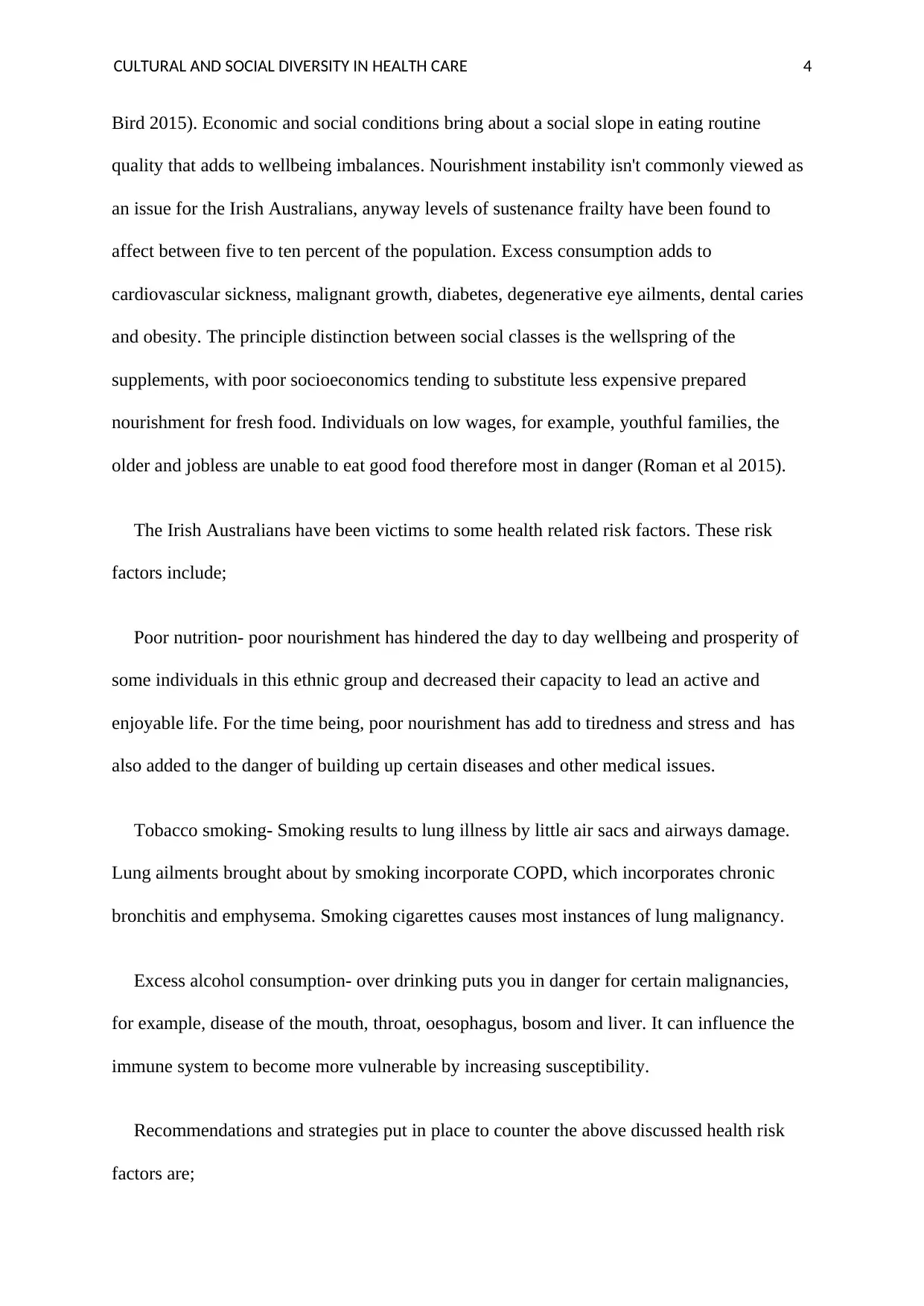
CULTURAL AND SOCIAL DIVERSITY IN HEALTH CARE 4
Bird 2015). Economic and social conditions bring about a social slope in eating routine
quality that adds to wellbeing imbalances. Nourishment instability isn't commonly viewed as
an issue for the Irish Australians, anyway levels of sustenance frailty have been found to
affect between five to ten percent of the population. Excess consumption adds to
cardiovascular sickness, malignant growth, diabetes, degenerative eye ailments, dental caries
and obesity. The principle distinction between social classes is the wellspring of the
supplements, with poor socioeconomics tending to substitute less expensive prepared
nourishment for fresh food. Individuals on low wages, for example, youthful families, the
older and jobless are unable to eat good food therefore most in danger (Roman et al 2015).
The Irish Australians have been victims to some health related risk factors. These risk
factors include;
Poor nutrition- poor nourishment has hindered the day to day wellbeing and prosperity of
some individuals in this ethnic group and decreased their capacity to lead an active and
enjoyable life. For the time being, poor nourishment has add to tiredness and stress and has
also added to the danger of building up certain diseases and other medical issues.
Tobacco smoking- Smoking results to lung illness by little air sacs and airways damage.
Lung ailments brought about by smoking incorporate COPD, which incorporates chronic
bronchitis and emphysema. Smoking cigarettes causes most instances of lung malignancy.
Excess alcohol consumption- over drinking puts you in danger for certain malignancies,
for example, disease of the mouth, throat, oesophagus, bosom and liver. It can influence the
immune system to become more vulnerable by increasing susceptibility.
Recommendations and strategies put in place to counter the above discussed health risk
factors are;
Bird 2015). Economic and social conditions bring about a social slope in eating routine
quality that adds to wellbeing imbalances. Nourishment instability isn't commonly viewed as
an issue for the Irish Australians, anyway levels of sustenance frailty have been found to
affect between five to ten percent of the population. Excess consumption adds to
cardiovascular sickness, malignant growth, diabetes, degenerative eye ailments, dental caries
and obesity. The principle distinction between social classes is the wellspring of the
supplements, with poor socioeconomics tending to substitute less expensive prepared
nourishment for fresh food. Individuals on low wages, for example, youthful families, the
older and jobless are unable to eat good food therefore most in danger (Roman et al 2015).
The Irish Australians have been victims to some health related risk factors. These risk
factors include;
Poor nutrition- poor nourishment has hindered the day to day wellbeing and prosperity of
some individuals in this ethnic group and decreased their capacity to lead an active and
enjoyable life. For the time being, poor nourishment has add to tiredness and stress and has
also added to the danger of building up certain diseases and other medical issues.
Tobacco smoking- Smoking results to lung illness by little air sacs and airways damage.
Lung ailments brought about by smoking incorporate COPD, which incorporates chronic
bronchitis and emphysema. Smoking cigarettes causes most instances of lung malignancy.
Excess alcohol consumption- over drinking puts you in danger for certain malignancies,
for example, disease of the mouth, throat, oesophagus, bosom and liver. It can influence the
immune system to become more vulnerable by increasing susceptibility.
Recommendations and strategies put in place to counter the above discussed health risk
factors are;
Paraphrase This Document
Need a fresh take? Get an instant paraphrase of this document with our AI Paraphraser
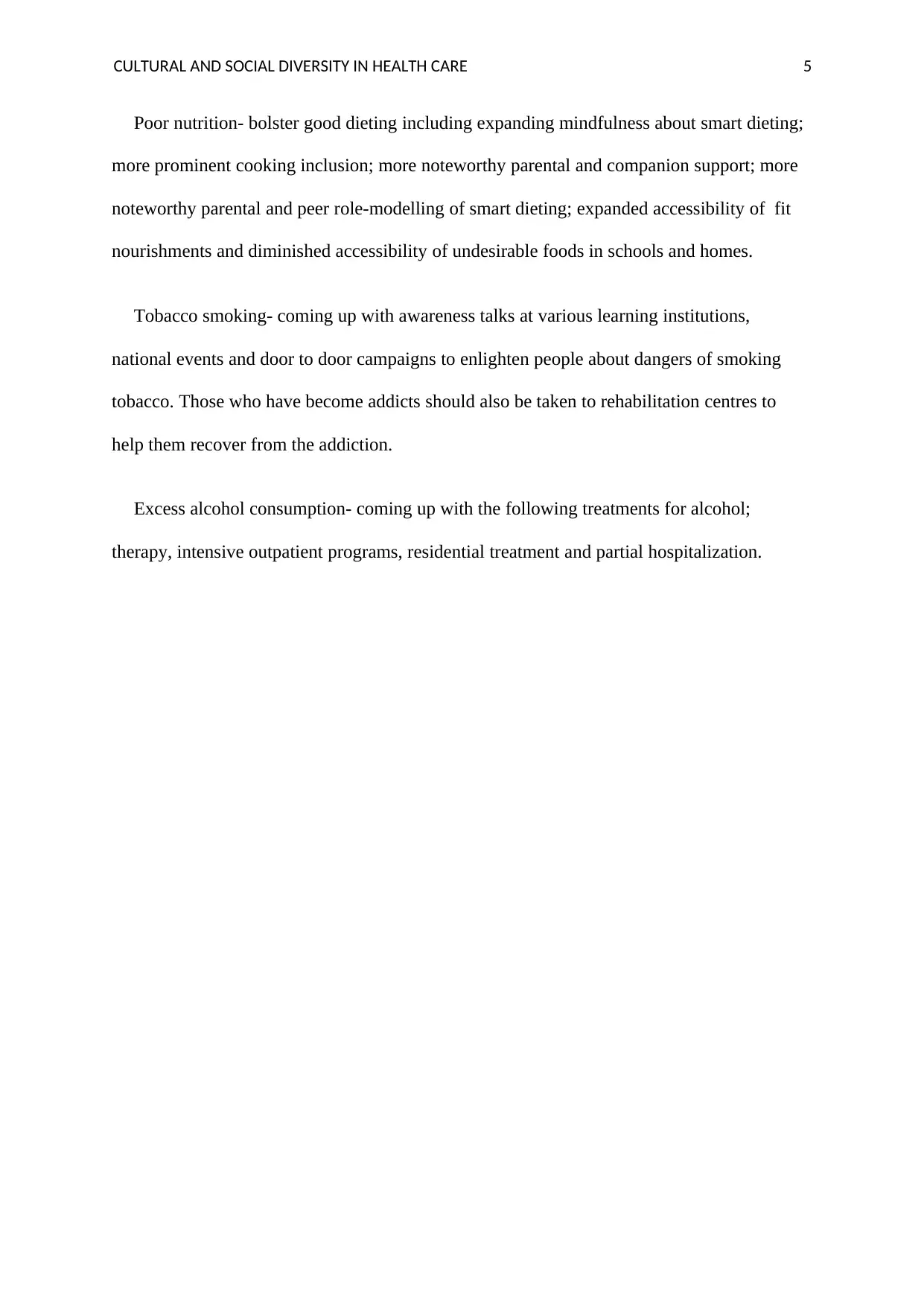
CULTURAL AND SOCIAL DIVERSITY IN HEALTH CARE 5
Poor nutrition- bolster good dieting including expanding mindfulness about smart dieting;
more prominent cooking inclusion; more noteworthy parental and companion support; more
noteworthy parental and peer role-modelling of smart dieting; expanded accessibility of fit
nourishments and diminished accessibility of undesirable foods in schools and homes.
Tobacco smoking- coming up with awareness talks at various learning institutions,
national events and door to door campaigns to enlighten people about dangers of smoking
tobacco. Those who have become addicts should also be taken to rehabilitation centres to
help them recover from the addiction.
Excess alcohol consumption- coming up with the following treatments for alcohol;
therapy, intensive outpatient programs, residential treatment and partial hospitalization.
Poor nutrition- bolster good dieting including expanding mindfulness about smart dieting;
more prominent cooking inclusion; more noteworthy parental and companion support; more
noteworthy parental and peer role-modelling of smart dieting; expanded accessibility of fit
nourishments and diminished accessibility of undesirable foods in schools and homes.
Tobacco smoking- coming up with awareness talks at various learning institutions,
national events and door to door campaigns to enlighten people about dangers of smoking
tobacco. Those who have become addicts should also be taken to rehabilitation centres to
help them recover from the addiction.
Excess alcohol consumption- coming up with the following treatments for alcohol;
therapy, intensive outpatient programs, residential treatment and partial hospitalization.
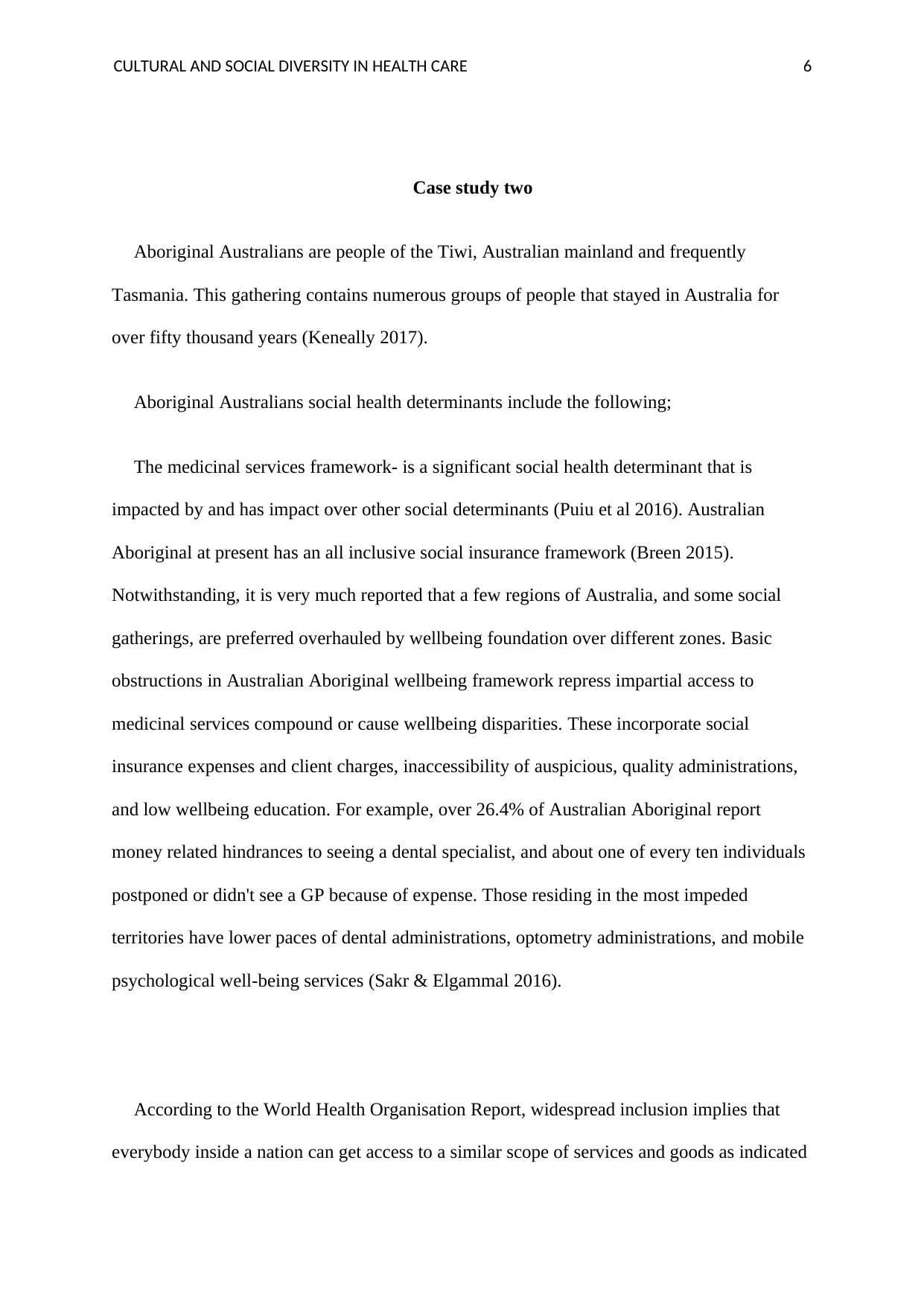
CULTURAL AND SOCIAL DIVERSITY IN HEALTH CARE 6
Case study two
Aboriginal Australians are people of the Tiwi, Australian mainland and frequently
Tasmania. This gathering contains numerous groups of people that stayed in Australia for
over fifty thousand years (Keneally 2017).
Aboriginal Australians social health determinants include the following;
The medicinal services framework- is a significant social health determinant that is
impacted by and has impact over other social determinants (Puiu et al 2016). Australian
Aboriginal at present has an all inclusive social insurance framework (Breen 2015).
Notwithstanding, it is very much reported that a few regions of Australia, and some social
gatherings, are preferred overhauled by wellbeing foundation over different zones. Basic
obstructions in Australian Aboriginal wellbeing framework repress impartial access to
medicinal services compound or cause wellbeing disparities. These incorporate social
insurance expenses and client charges, inaccessibility of auspicious, quality administrations,
and low wellbeing education. For example, over 26.4% of Australian Aboriginal report
money related hindrances to seeing a dental specialist, and about one of every ten individuals
postponed or didn't see a GP because of expense. Those residing in the most impeded
territories have lower paces of dental administrations, optometry administrations, and mobile
psychological well-being services (Sakr & Elgammal 2016).
According to the World Health Organisation Report, widespread inclusion implies that
everybody inside a nation can get access to a similar scope of services and goods as indicated
Case study two
Aboriginal Australians are people of the Tiwi, Australian mainland and frequently
Tasmania. This gathering contains numerous groups of people that stayed in Australia for
over fifty thousand years (Keneally 2017).
Aboriginal Australians social health determinants include the following;
The medicinal services framework- is a significant social health determinant that is
impacted by and has impact over other social determinants (Puiu et al 2016). Australian
Aboriginal at present has an all inclusive social insurance framework (Breen 2015).
Notwithstanding, it is very much reported that a few regions of Australia, and some social
gatherings, are preferred overhauled by wellbeing foundation over different zones. Basic
obstructions in Australian Aboriginal wellbeing framework repress impartial access to
medicinal services compound or cause wellbeing disparities. These incorporate social
insurance expenses and client charges, inaccessibility of auspicious, quality administrations,
and low wellbeing education. For example, over 26.4% of Australian Aboriginal report
money related hindrances to seeing a dental specialist, and about one of every ten individuals
postponed or didn't see a GP because of expense. Those residing in the most impeded
territories have lower paces of dental administrations, optometry administrations, and mobile
psychological well-being services (Sakr & Elgammal 2016).
According to the World Health Organisation Report, widespread inclusion implies that
everybody inside a nation can get access to a similar scope of services and goods as indicated
⊘ This is a preview!⊘
Do you want full access?
Subscribe today to unlock all pages.

Trusted by 1+ million students worldwide
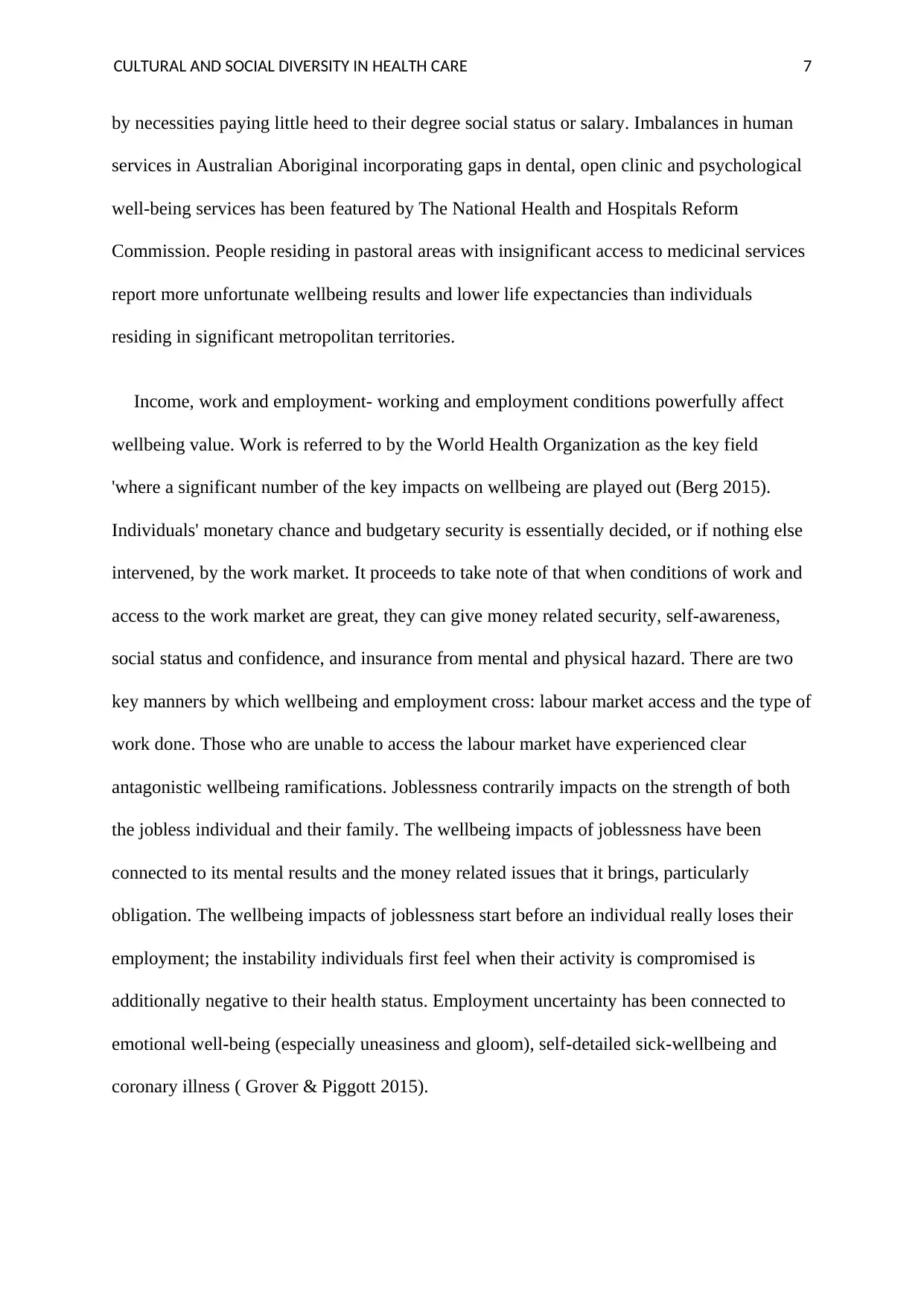
CULTURAL AND SOCIAL DIVERSITY IN HEALTH CARE 7
by necessities paying little heed to their degree social status or salary. Imbalances in human
services in Australian Aboriginal incorporating gaps in dental, open clinic and psychological
well-being services has been featured by The National Health and Hospitals Reform
Commission. People residing in pastoral areas with insignificant access to medicinal services
report more unfortunate wellbeing results and lower life expectancies than individuals
residing in significant metropolitan territories.
Income, work and employment- working and employment conditions powerfully affect
wellbeing value. Work is referred to by the World Health Organization as the key field
'where a significant number of the key impacts on wellbeing are played out (Berg 2015).
Individuals' monetary chance and budgetary security is essentially decided, or if nothing else
intervened, by the work market. It proceeds to take note of that when conditions of work and
access to the work market are great, they can give money related security, self-awareness,
social status and confidence, and insurance from mental and physical hazard. There are two
key manners by which wellbeing and employment cross: labour market access and the type of
work done. Those who are unable to access the labour market have experienced clear
antagonistic wellbeing ramifications. Joblessness contrarily impacts on the strength of both
the jobless individual and their family. The wellbeing impacts of joblessness have been
connected to its mental results and the money related issues that it brings, particularly
obligation. The wellbeing impacts of joblessness start before an individual really loses their
employment; the instability individuals first feel when their activity is compromised is
additionally negative to their health status. Employment uncertainty has been connected to
emotional well-being (especially uneasiness and gloom), self-detailed sick-wellbeing and
coronary illness ( Grover & Piggott 2015).
by necessities paying little heed to their degree social status or salary. Imbalances in human
services in Australian Aboriginal incorporating gaps in dental, open clinic and psychological
well-being services has been featured by The National Health and Hospitals Reform
Commission. People residing in pastoral areas with insignificant access to medicinal services
report more unfortunate wellbeing results and lower life expectancies than individuals
residing in significant metropolitan territories.
Income, work and employment- working and employment conditions powerfully affect
wellbeing value. Work is referred to by the World Health Organization as the key field
'where a significant number of the key impacts on wellbeing are played out (Berg 2015).
Individuals' monetary chance and budgetary security is essentially decided, or if nothing else
intervened, by the work market. It proceeds to take note of that when conditions of work and
access to the work market are great, they can give money related security, self-awareness,
social status and confidence, and insurance from mental and physical hazard. There are two
key manners by which wellbeing and employment cross: labour market access and the type of
work done. Those who are unable to access the labour market have experienced clear
antagonistic wellbeing ramifications. Joblessness contrarily impacts on the strength of both
the jobless individual and their family. The wellbeing impacts of joblessness have been
connected to its mental results and the money related issues that it brings, particularly
obligation. The wellbeing impacts of joblessness start before an individual really loses their
employment; the instability individuals first feel when their activity is compromised is
additionally negative to their health status. Employment uncertainty has been connected to
emotional well-being (especially uneasiness and gloom), self-detailed sick-wellbeing and
coronary illness ( Grover & Piggott 2015).
Paraphrase This Document
Need a fresh take? Get an instant paraphrase of this document with our AI Paraphraser
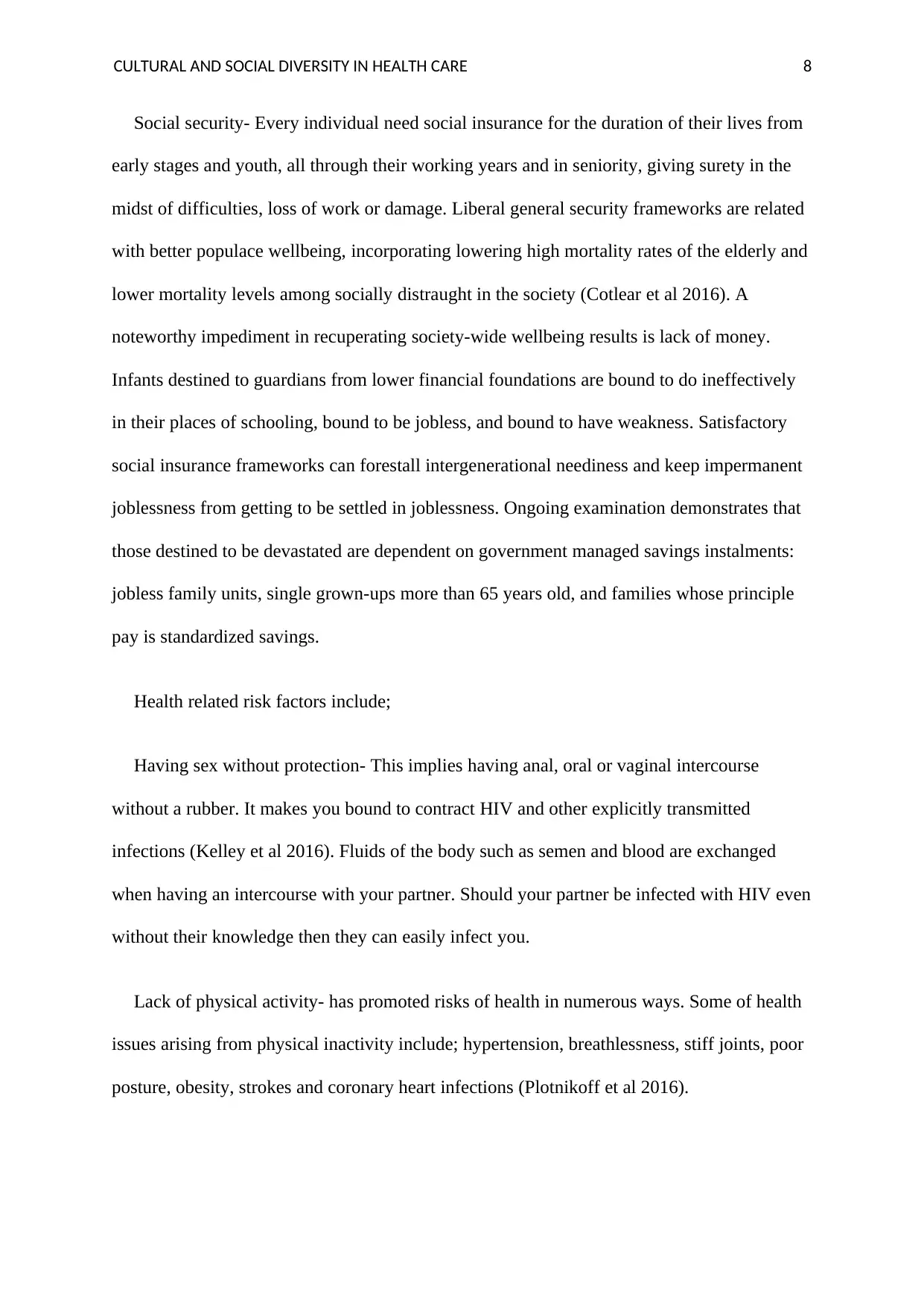
CULTURAL AND SOCIAL DIVERSITY IN HEALTH CARE 8
Social security- Every individual need social insurance for the duration of their lives from
early stages and youth, all through their working years and in seniority, giving surety in the
midst of difficulties, loss of work or damage. Liberal general security frameworks are related
with better populace wellbeing, incorporating lowering high mortality rates of the elderly and
lower mortality levels among socially distraught in the society (Cotlear et al 2016). A
noteworthy impediment in recuperating society-wide wellbeing results is lack of money.
Infants destined to guardians from lower financial foundations are bound to do ineffectively
in their places of schooling, bound to be jobless, and bound to have weakness. Satisfactory
social insurance frameworks can forestall intergenerational neediness and keep impermanent
joblessness from getting to be settled in joblessness. Ongoing examination demonstrates that
those destined to be devastated are dependent on government managed savings instalments:
jobless family units, single grown-ups more than 65 years old, and families whose principle
pay is standardized savings.
Health related risk factors include;
Having sex without protection- This implies having anal, oral or vaginal intercourse
without a rubber. It makes you bound to contract HIV and other explicitly transmitted
infections (Kelley et al 2016). Fluids of the body such as semen and blood are exchanged
when having an intercourse with your partner. Should your partner be infected with HIV even
without their knowledge then they can easily infect you.
Lack of physical activity- has promoted risks of health in numerous ways. Some of health
issues arising from physical inactivity include; hypertension, breathlessness, stiff joints, poor
posture, obesity, strokes and coronary heart infections (Plotnikoff et al 2016).
Social security- Every individual need social insurance for the duration of their lives from
early stages and youth, all through their working years and in seniority, giving surety in the
midst of difficulties, loss of work or damage. Liberal general security frameworks are related
with better populace wellbeing, incorporating lowering high mortality rates of the elderly and
lower mortality levels among socially distraught in the society (Cotlear et al 2016). A
noteworthy impediment in recuperating society-wide wellbeing results is lack of money.
Infants destined to guardians from lower financial foundations are bound to do ineffectively
in their places of schooling, bound to be jobless, and bound to have weakness. Satisfactory
social insurance frameworks can forestall intergenerational neediness and keep impermanent
joblessness from getting to be settled in joblessness. Ongoing examination demonstrates that
those destined to be devastated are dependent on government managed savings instalments:
jobless family units, single grown-ups more than 65 years old, and families whose principle
pay is standardized savings.
Health related risk factors include;
Having sex without protection- This implies having anal, oral or vaginal intercourse
without a rubber. It makes you bound to contract HIV and other explicitly transmitted
infections (Kelley et al 2016). Fluids of the body such as semen and blood are exchanged
when having an intercourse with your partner. Should your partner be infected with HIV even
without their knowledge then they can easily infect you.
Lack of physical activity- has promoted risks of health in numerous ways. Some of health
issues arising from physical inactivity include; hypertension, breathlessness, stiff joints, poor
posture, obesity, strokes and coronary heart infections (Plotnikoff et al 2016).
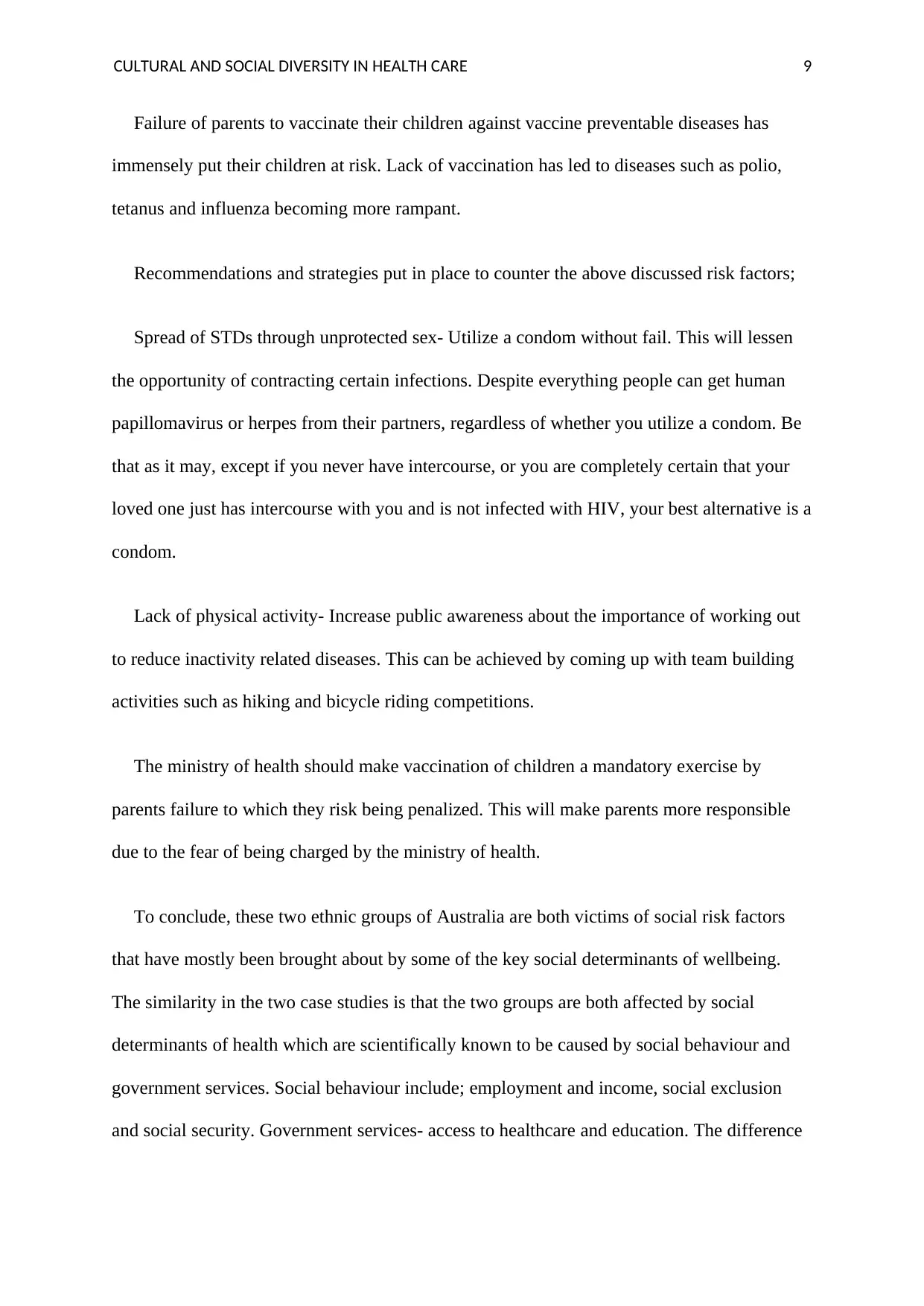
CULTURAL AND SOCIAL DIVERSITY IN HEALTH CARE 9
Failure of parents to vaccinate their children against vaccine preventable diseases has
immensely put their children at risk. Lack of vaccination has led to diseases such as polio,
tetanus and influenza becoming more rampant.
Recommendations and strategies put in place to counter the above discussed risk factors;
Spread of STDs through unprotected sex- Utilize a condom without fail. This will lessen
the opportunity of contracting certain infections. Despite everything people can get human
papillomavirus or herpes from their partners, regardless of whether you utilize a condom. Be
that as it may, except if you never have intercourse, or you are completely certain that your
loved one just has intercourse with you and is not infected with HIV, your best alternative is a
condom.
Lack of physical activity- Increase public awareness about the importance of working out
to reduce inactivity related diseases. This can be achieved by coming up with team building
activities such as hiking and bicycle riding competitions.
The ministry of health should make vaccination of children a mandatory exercise by
parents failure to which they risk being penalized. This will make parents more responsible
due to the fear of being charged by the ministry of health.
To conclude, these two ethnic groups of Australia are both victims of social risk factors
that have mostly been brought about by some of the key social determinants of wellbeing.
The similarity in the two case studies is that the two groups are both affected by social
determinants of health which are scientifically known to be caused by social behaviour and
government services. Social behaviour include; employment and income, social exclusion
and social security. Government services- access to healthcare and education. The difference
Failure of parents to vaccinate their children against vaccine preventable diseases has
immensely put their children at risk. Lack of vaccination has led to diseases such as polio,
tetanus and influenza becoming more rampant.
Recommendations and strategies put in place to counter the above discussed risk factors;
Spread of STDs through unprotected sex- Utilize a condom without fail. This will lessen
the opportunity of contracting certain infections. Despite everything people can get human
papillomavirus or herpes from their partners, regardless of whether you utilize a condom. Be
that as it may, except if you never have intercourse, or you are completely certain that your
loved one just has intercourse with you and is not infected with HIV, your best alternative is a
condom.
Lack of physical activity- Increase public awareness about the importance of working out
to reduce inactivity related diseases. This can be achieved by coming up with team building
activities such as hiking and bicycle riding competitions.
The ministry of health should make vaccination of children a mandatory exercise by
parents failure to which they risk being penalized. This will make parents more responsible
due to the fear of being charged by the ministry of health.
To conclude, these two ethnic groups of Australia are both victims of social risk factors
that have mostly been brought about by some of the key social determinants of wellbeing.
The similarity in the two case studies is that the two groups are both affected by social
determinants of health which are scientifically known to be caused by social behaviour and
government services. Social behaviour include; employment and income, social exclusion
and social security. Government services- access to healthcare and education. The difference
⊘ This is a preview!⊘
Do you want full access?
Subscribe today to unlock all pages.

Trusted by 1+ million students worldwide
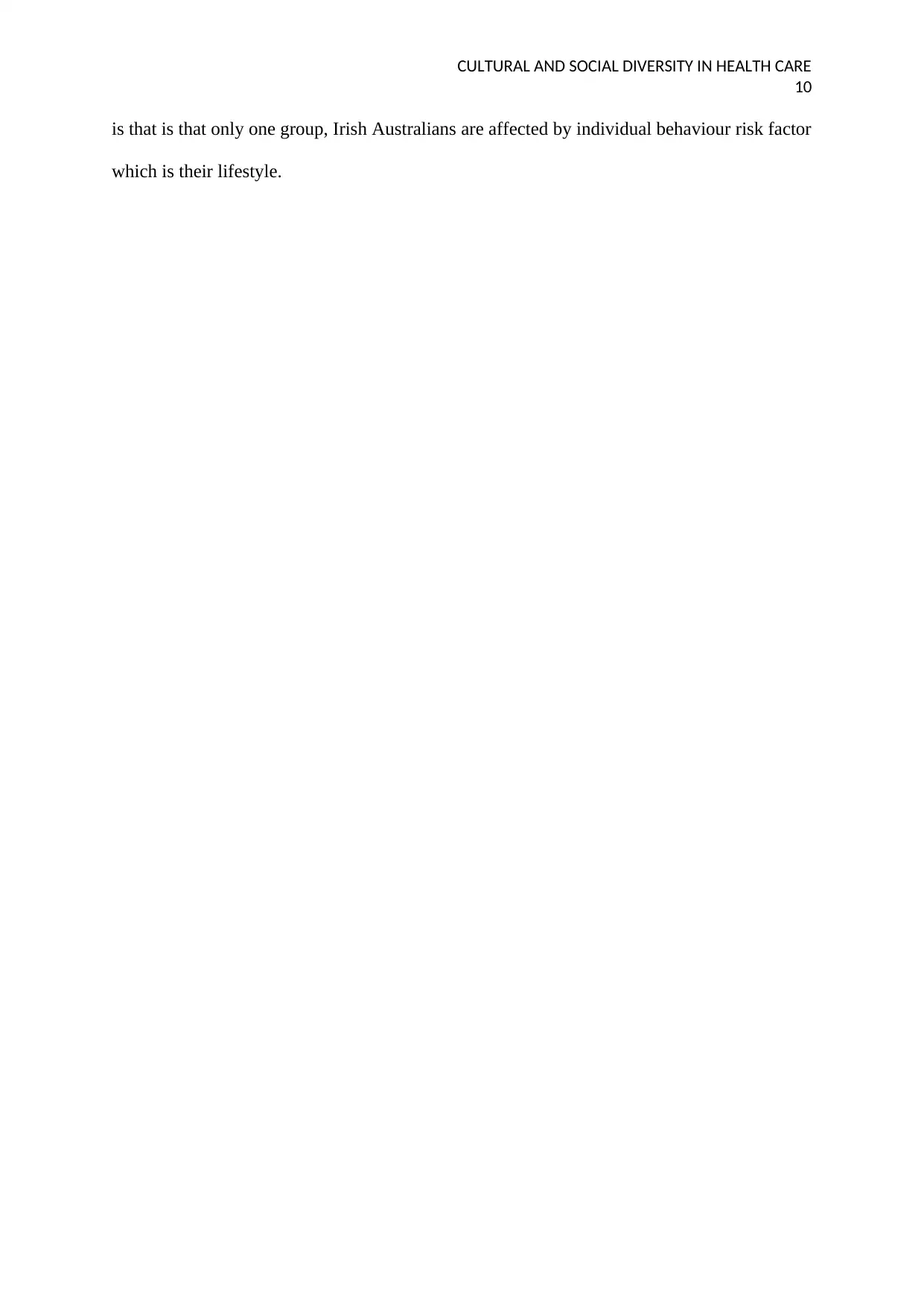
CULTURAL AND SOCIAL DIVERSITY IN HEALTH CARE
10
is that is that only one group, Irish Australians are affected by individual behaviour risk factor
which is their lifestyle.
10
is that is that only one group, Irish Australians are affected by individual behaviour risk factor
which is their lifestyle.
Paraphrase This Document
Need a fresh take? Get an instant paraphrase of this document with our AI Paraphraser
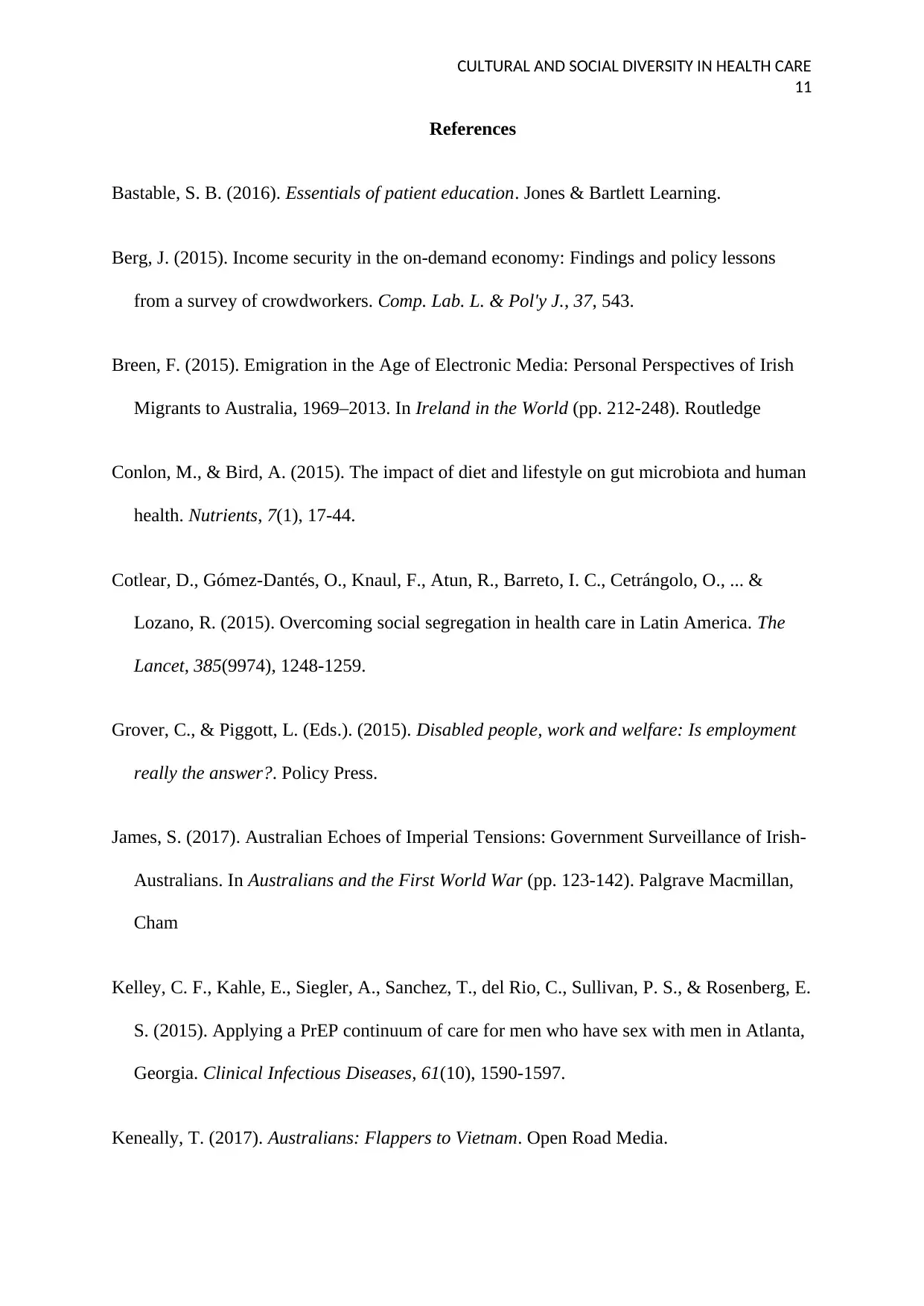
CULTURAL AND SOCIAL DIVERSITY IN HEALTH CARE
11
References
Bastable, S. B. (2016). Essentials of patient education. Jones & Bartlett Learning.
Berg, J. (2015). Income security in the on-demand economy: Findings and policy lessons
from a survey of crowdworkers. Comp. Lab. L. & Pol'y J., 37, 543.
Breen, F. (2015). Emigration in the Age of Electronic Media: Personal Perspectives of Irish
Migrants to Australia, 1969–2013. In Ireland in the World (pp. 212-248). Routledge
Conlon, M., & Bird, A. (2015). The impact of diet and lifestyle on gut microbiota and human
health. Nutrients, 7(1), 17-44.
Cotlear, D., Gómez-Dantés, O., Knaul, F., Atun, R., Barreto, I. C., Cetrángolo, O., ... &
Lozano, R. (2015). Overcoming social segregation in health care in Latin America. The
Lancet, 385(9974), 1248-1259.
Grover, C., & Piggott, L. (Eds.). (2015). Disabled people, work and welfare: Is employment
really the answer?. Policy Press.
James, S. (2017). Australian Echoes of Imperial Tensions: Government Surveillance of Irish-
Australians. In Australians and the First World War (pp. 123-142). Palgrave Macmillan,
Cham
Kelley, C. F., Kahle, E., Siegler, A., Sanchez, T., del Rio, C., Sullivan, P. S., & Rosenberg, E.
S. (2015). Applying a PrEP continuum of care for men who have sex with men in Atlanta,
Georgia. Clinical Infectious Diseases, 61(10), 1590-1597.
Keneally, T. (2017). Australians: Flappers to Vietnam. Open Road Media.
11
References
Bastable, S. B. (2016). Essentials of patient education. Jones & Bartlett Learning.
Berg, J. (2015). Income security in the on-demand economy: Findings and policy lessons
from a survey of crowdworkers. Comp. Lab. L. & Pol'y J., 37, 543.
Breen, F. (2015). Emigration in the Age of Electronic Media: Personal Perspectives of Irish
Migrants to Australia, 1969–2013. In Ireland in the World (pp. 212-248). Routledge
Conlon, M., & Bird, A. (2015). The impact of diet and lifestyle on gut microbiota and human
health. Nutrients, 7(1), 17-44.
Cotlear, D., Gómez-Dantés, O., Knaul, F., Atun, R., Barreto, I. C., Cetrángolo, O., ... &
Lozano, R. (2015). Overcoming social segregation in health care in Latin America. The
Lancet, 385(9974), 1248-1259.
Grover, C., & Piggott, L. (Eds.). (2015). Disabled people, work and welfare: Is employment
really the answer?. Policy Press.
James, S. (2017). Australian Echoes of Imperial Tensions: Government Surveillance of Irish-
Australians. In Australians and the First World War (pp. 123-142). Palgrave Macmillan,
Cham
Kelley, C. F., Kahle, E., Siegler, A., Sanchez, T., del Rio, C., Sullivan, P. S., & Rosenberg, E.
S. (2015). Applying a PrEP continuum of care for men who have sex with men in Atlanta,
Georgia. Clinical Infectious Diseases, 61(10), 1590-1597.
Keneally, T. (2017). Australians: Flappers to Vietnam. Open Road Media.
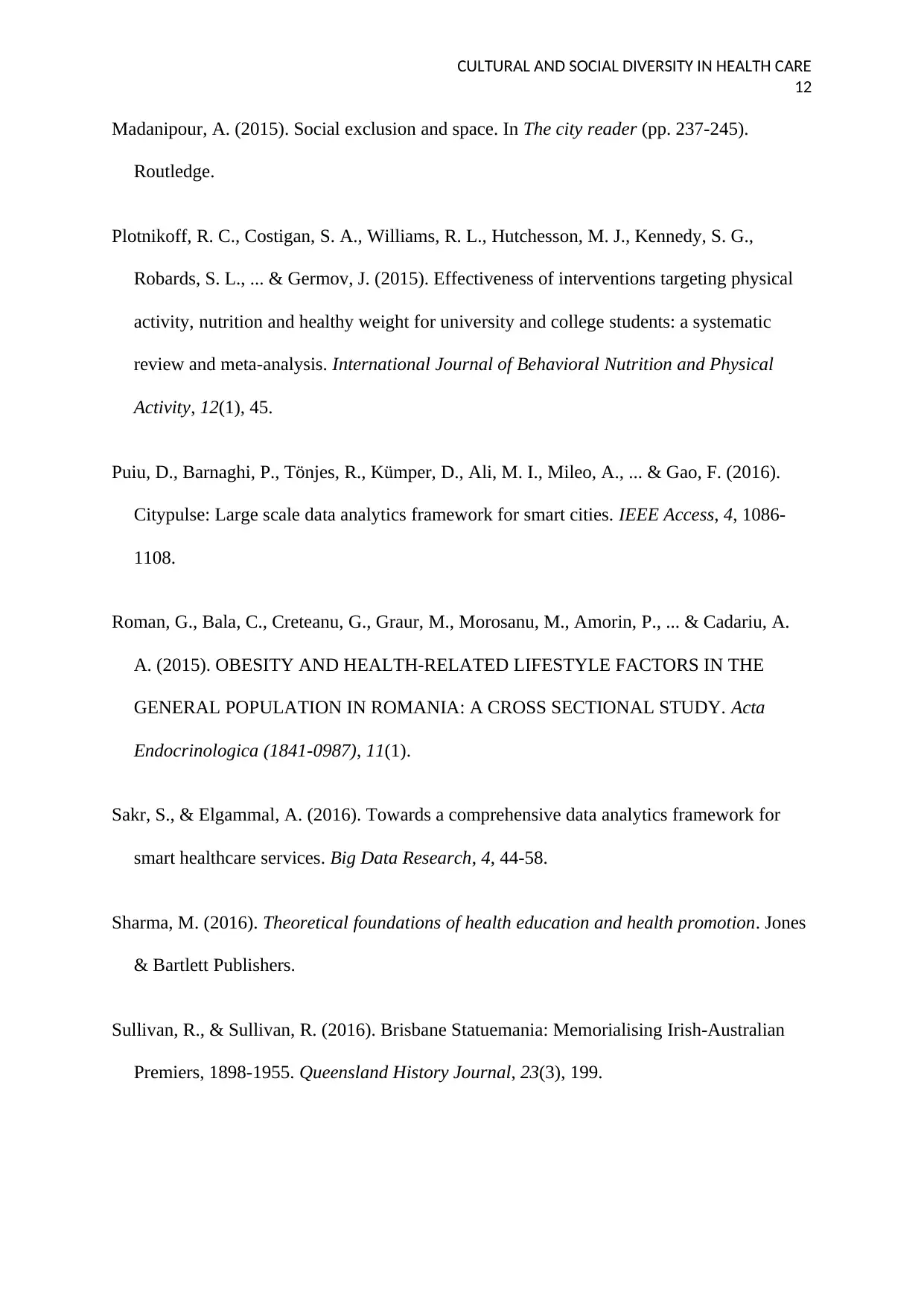
CULTURAL AND SOCIAL DIVERSITY IN HEALTH CARE
12
Madanipour, A. (2015). Social exclusion and space. In The city reader (pp. 237-245).
Routledge.
Plotnikoff, R. C., Costigan, S. A., Williams, R. L., Hutchesson, M. J., Kennedy, S. G.,
Robards, S. L., ... & Germov, J. (2015). Effectiveness of interventions targeting physical
activity, nutrition and healthy weight for university and college students: a systematic
review and meta-analysis. International Journal of Behavioral Nutrition and Physical
Activity, 12(1), 45.
Puiu, D., Barnaghi, P., Tönjes, R., Kümper, D., Ali, M. I., Mileo, A., ... & Gao, F. (2016).
Citypulse: Large scale data analytics framework for smart cities. IEEE Access, 4, 1086-
1108.
Roman, G., Bala, C., Creteanu, G., Graur, M., Morosanu, M., Amorin, P., ... & Cadariu, A.
A. (2015). OBESITY AND HEALTH-RELATED LIFESTYLE FACTORS IN THE
GENERAL POPULATION IN ROMANIA: A CROSS SECTIONAL STUDY. Acta
Endocrinologica (1841-0987), 11(1).
Sakr, S., & Elgammal, A. (2016). Towards a comprehensive data analytics framework for
smart healthcare services. Big Data Research, 4, 44-58.
Sharma, M. (2016). Theoretical foundations of health education and health promotion. Jones
& Bartlett Publishers.
Sullivan, R., & Sullivan, R. (2016). Brisbane Statuemania: Memorialising Irish-Australian
Premiers, 1898-1955. Queensland History Journal, 23(3), 199.
12
Madanipour, A. (2015). Social exclusion and space. In The city reader (pp. 237-245).
Routledge.
Plotnikoff, R. C., Costigan, S. A., Williams, R. L., Hutchesson, M. J., Kennedy, S. G.,
Robards, S. L., ... & Germov, J. (2015). Effectiveness of interventions targeting physical
activity, nutrition and healthy weight for university and college students: a systematic
review and meta-analysis. International Journal of Behavioral Nutrition and Physical
Activity, 12(1), 45.
Puiu, D., Barnaghi, P., Tönjes, R., Kümper, D., Ali, M. I., Mileo, A., ... & Gao, F. (2016).
Citypulse: Large scale data analytics framework for smart cities. IEEE Access, 4, 1086-
1108.
Roman, G., Bala, C., Creteanu, G., Graur, M., Morosanu, M., Amorin, P., ... & Cadariu, A.
A. (2015). OBESITY AND HEALTH-RELATED LIFESTYLE FACTORS IN THE
GENERAL POPULATION IN ROMANIA: A CROSS SECTIONAL STUDY. Acta
Endocrinologica (1841-0987), 11(1).
Sakr, S., & Elgammal, A. (2016). Towards a comprehensive data analytics framework for
smart healthcare services. Big Data Research, 4, 44-58.
Sharma, M. (2016). Theoretical foundations of health education and health promotion. Jones
& Bartlett Publishers.
Sullivan, R., & Sullivan, R. (2016). Brisbane Statuemania: Memorialising Irish-Australian
Premiers, 1898-1955. Queensland History Journal, 23(3), 199.
⊘ This is a preview!⊘
Do you want full access?
Subscribe today to unlock all pages.

Trusted by 1+ million students worldwide
1 out of 12
Related Documents
Your All-in-One AI-Powered Toolkit for Academic Success.
+13062052269
info@desklib.com
Available 24*7 on WhatsApp / Email
![[object Object]](/_next/static/media/star-bottom.7253800d.svg)
Unlock your academic potential
Copyright © 2020–2025 A2Z Services. All Rights Reserved. Developed and managed by ZUCOL.




